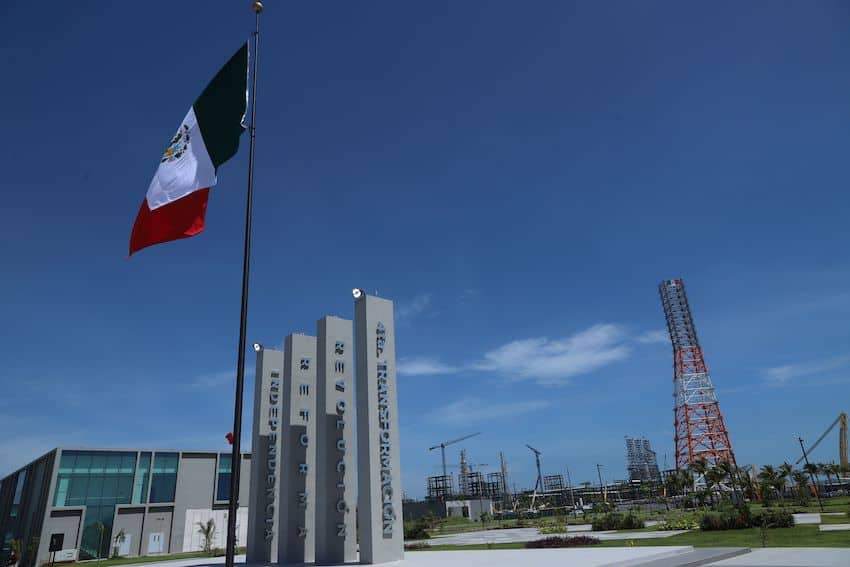Mexico’s construction sector is experiencing a remarkable surge in activity, driven by the concerted efforts to enhance public infrastructure. The latest data from Mexico’s national statistics agency INEGI reveals that the value of construction sector production saw an impressive annual increase of 45.8% in August, reaching its highest level since President López Obrador took office almost five years ago. The sector’s activity was valued at an estimated 63.16 billion pesos (US $3.45 billion) in August, highlighting the robust health of the industry.
A significant portion of the construction sector’s growth was attributed to various projects, with over 37% stemming from residential, industrial, commercial, educational, and healthcare construction. These segments recorded a 20.5% increase compared to August of the previous year. Additionally, “transport and urbanization projects,” encompassing rail, highways, and airports, accounted for 33.2% of the total, with a remarkable 133.7% increase in value.
The oil and petrochemical sub-sector contributed approximately 10% to the overall value of construction, with a notable exception as it declined by 2% in annual terms.
INEGI’s National Survey of Construction Companies, published recently, also indicated positive trends in employment, working hours, and wages within the construction sector. Employment grew by 1.9% compared to the previous August, hours worked rose by 9.8%, and average wages increased by 5.5%, reflecting an improved labor market in the industry.
Private sector projects played a significant role, accounting for 52.4% of the total value of construction sector production, while public projects contributed the remaining 47.6%, with transport infrastructure projects playing a prominent role in this share. This marked an unprecedented level of public sector participation, as noted by Gabriela Siller, director of economic analysis at Mexican bank Banco Base.
The federal government’s ambitious infrastructure-building agenda, initiated by President López Obrador since he took office in December 2018, played a pivotal role in driving the construction sector’s growth. Notable projects such as the Maya Train railroad, the modernization of tracks across the Isthmus of Tehuantepec, and the new Pemex oil refinery have significantly contributed to the positive results in August.
This upward trajectory is set to continue, as the government remains committed to investing in its signature infrastructure projects. The completion of the new Tulum airport and the Mexico City-Toluca passenger train line are among the projects anticipated to further boost the construction sector’s value.
In August, the total value of construction sector production increased by 5% compared to July, maintaining a winning streak that began in March. The number of construction sector workers increased by 0.9%, working hours rose by 1%, and average salaries jumped by 3.3%. Quintana Roo, the state on the Caribbean coast where work on the Maya Train and Tulum airport is nearing completion, claimed the largest share of construction production in August, with 15.8% of the total value. Tabasco was the leader in the oil sector, accounting for 38% of the construction value.
Julio Santaella, an economist and former president of INEGI, pointed out substantial growth in construction projects in Tamaulipas, Coahuila, and Chihuahua in August. These remarkable increases are consistent with the “nearshoring” phenomenon, in which foreign companies relocate to Mexico to be closer to the United States market.
Although the future of the construction sector looks promising, there is a note of caution. Gabriela Siller warns that the value of construction sector production could “plummet” in 2025 due to a potential lack of government resources for large infrastructure projects. However, the private sector, buoyed by significant foreign investment, particularly in industrial and commercial building projects, is expected to help offset this decline, especially as more companies participate in the nearshoring trend, with plans to establish operations in Mexico.
Approximately 33.9% of total private sector construction production in August came from industrial and commercial building projects, which saw a remarkable 23.3% increase in value on a year-over-year basis. With companies like Tesla, Ternium, and Kawasaki announcing plans to build plants in Mexico, the outlook for the construction sector remains bright as more businesses tap into the country’s growing potential.
(Source: Mexico News Daily | El Economista)









